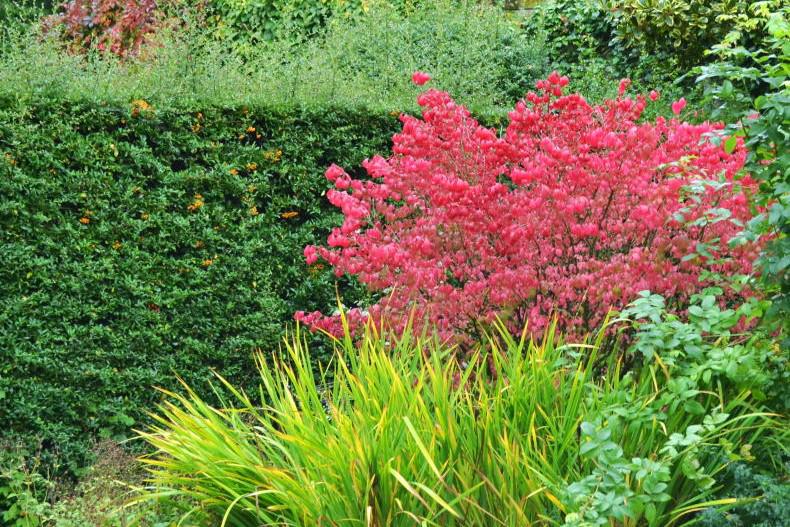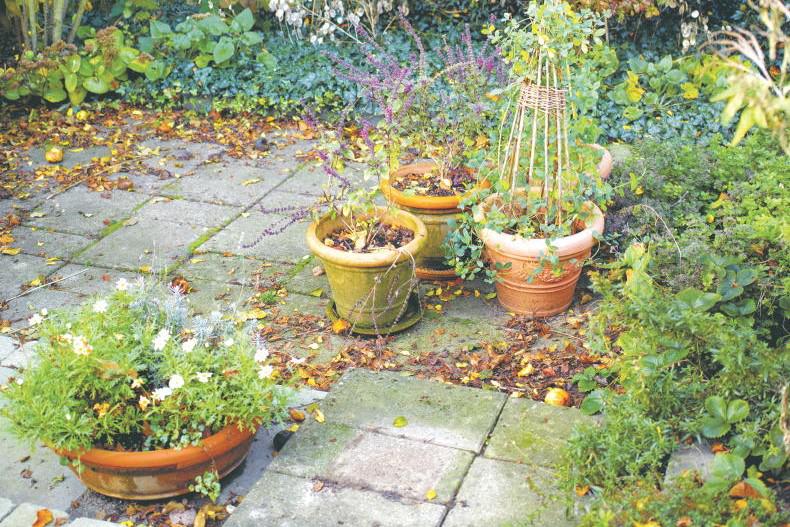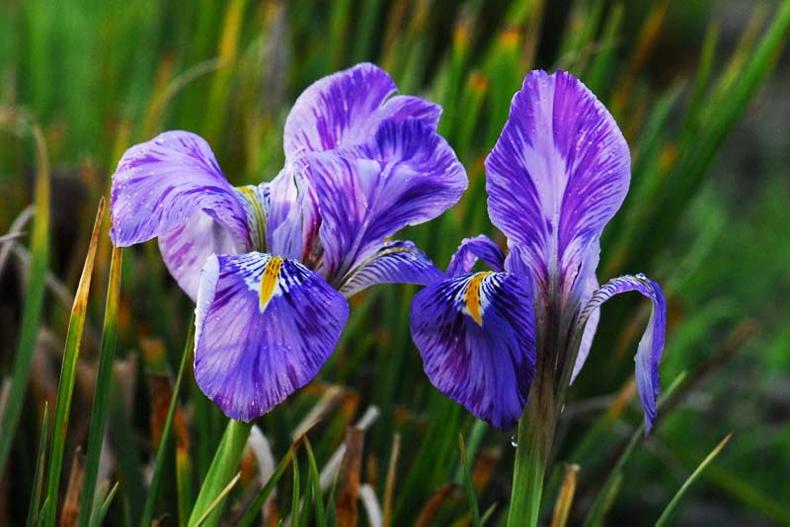Botanical name: In the seventeenth century, the Swedish botanist Linnaeus named the nerine lily Nerine sarniensis, meaning ‘the nerine from Guernsey’. It had been found growing on that island; washed up after a ship sailing from Japan to Holland was wrecked. It is, in fact, from South Africa and it was later concluded that the ships coming from Japan took it on board at the Cape when they were being re-provisioned for the final leg of their long voyage.
Family: There are several species of nerine lily and immense variation within the wild populations. They are in the amaryllis
family. Some species, such as Nerine sarniensis, come in many shades - from deep red to light pink, rose and even a brilliant scarlet. The most commonly grown kind is Nerine bowdenii, which generally comes in shades of pink. It is a form of this species that is widely grown in Europe, including Ireland, and it is considered the hardiest.
Garden value
The bulbs of nerines are about the size of a small onion and only bulbs of this size will flower. It takes the bulbs a few years to reach flowering size and purchased bulbs sometimes do not flower until they grow bigger. Nerine hates to be disturbed and often flowers poorly for two or three years after a move. The bulbs push up out of the soil as they become congested. The bigger bulbs flower and then others reach flowering size, meaning a consistent floral display in the majority of cases.
Each rounded flower head contains up to about ten individual flowers and these open in succession, with a peak in October. The colour of the flowers is a brilliant hot pink with a glistening shiny surface to the petals. The individual petals are narrow, frilled and ruffled along the edge, curled back to give a lively appearance. The neon pink colour goes well with the yellows, oranges and browns of autumn, making a strong contrast. The best way to use nerines is to locate a few clumps at different points in the garden so that each clump plays off the other.
Growing nerines
Place them at the front of a bed or border for maximum impact. A sunny position with really good drainage is vital for good results. While they are hardy enough to grow in any part of the country, they do best in mild areas. In a really cold spell in frosty districts, the tops of the bulbs can be damaged and the topmost exposed bulbs can be killed. However, its stems are rigid against wind and nerine generally isn’t susceptible to pests or diseases. Once planted, it can be left in place for decades (all the more reason for choosing the planting site with care).

Home-grown ripe pears are incomparable in taste compared to any shop-bought pear / Gerry Daly
Picking pears
Pears are much more difficult to grow than apples. They need really good conditions to grow well. Yet, home-grown ripe pears are incomparable in taste compared to any shop-bought pear. This is not just down to varieties, because the main home-grown pear (‘Conference’) is also commercially important. Part of the art of growing pears is picking them at the right time and ripening them for eating.
Unlike apples, pears do not ripen on the tree. In natural conditions, they fall and ripen on the ground. Pick pears when they appear ripe and the first few fall to the ground. Then, ripen them in a shed or cool room, testing one every few days. Some take a couple of weeks; others, several weeks. Start using them as soon as they soften enough to eat as they will continue to soften.
Trees, shrubs and roses
Planting of all kinds of bare-root and root-ball deciduous trees, hedging and shrubs can continue in good weather. All kinds of pot-grown trees and shrubs can also be planted. Do not plant into saturated ground or into planting holes that fill with water, because the wet conditions cause the roots to rot.
Fruit, vegetables and herbs
Plant new fruit trees and bushes. Good quality plants are available in a very interesting range of varieties. Dig over vegetable ground, removing old crops.
Control weeds over areas of ground that will be cultivated later. Spread compost or rotted manure before digging or rotovating it in.
Flowers
Bedding plants for spring colour should be put in now, if not already done, clearing out old summer bedding from pots and flower beds. In frosty localities, lift dahlias, begonias and gladiolus to prevent winter damage. Cover them with soil in milder areas. Spring bulbs should be in by now or should be planted, if not.
Lawn
Sulphate of iron lawn mosskiller can be used now. Moss will grow strongly in the coming months and can build up to damaging levels. Keep on mowing as late as possible, if the soil is not wet and soft. Grass tends to grow a little over winter and an occasional mowing during dry weather will keep it neat.
Greenhouse and house plants
Remove all debris and dead plants and ventilate occasionally. Water very little to reduce the risk of grey mould disease.
Set up a greenhouse frost protection heater to protect tender plants, such as geraniums or fuchsias. On the lowest setting, this only comes on when frost threatens.
Read more
Gardening with Gerry: misty blue
Gardening with Gerry: Autumn beauty
Botanical name: In the seventeenth century, the Swedish botanist Linnaeus named the nerine lily Nerine sarniensis, meaning ‘the nerine from Guernsey’. It had been found growing on that island; washed up after a ship sailing from Japan to Holland was wrecked. It is, in fact, from South Africa and it was later concluded that the ships coming from Japan took it on board at the Cape when they were being re-provisioned for the final leg of their long voyage.
Family: There are several species of nerine lily and immense variation within the wild populations. They are in the amaryllis
family. Some species, such as Nerine sarniensis, come in many shades - from deep red to light pink, rose and even a brilliant scarlet. The most commonly grown kind is Nerine bowdenii, which generally comes in shades of pink. It is a form of this species that is widely grown in Europe, including Ireland, and it is considered the hardiest.
Garden value
The bulbs of nerines are about the size of a small onion and only bulbs of this size will flower. It takes the bulbs a few years to reach flowering size and purchased bulbs sometimes do not flower until they grow bigger. Nerine hates to be disturbed and often flowers poorly for two or three years after a move. The bulbs push up out of the soil as they become congested. The bigger bulbs flower and then others reach flowering size, meaning a consistent floral display in the majority of cases.
Each rounded flower head contains up to about ten individual flowers and these open in succession, with a peak in October. The colour of the flowers is a brilliant hot pink with a glistening shiny surface to the petals. The individual petals are narrow, frilled and ruffled along the edge, curled back to give a lively appearance. The neon pink colour goes well with the yellows, oranges and browns of autumn, making a strong contrast. The best way to use nerines is to locate a few clumps at different points in the garden so that each clump plays off the other.
Growing nerines
Place them at the front of a bed or border for maximum impact. A sunny position with really good drainage is vital for good results. While they are hardy enough to grow in any part of the country, they do best in mild areas. In a really cold spell in frosty districts, the tops of the bulbs can be damaged and the topmost exposed bulbs can be killed. However, its stems are rigid against wind and nerine generally isn’t susceptible to pests or diseases. Once planted, it can be left in place for decades (all the more reason for choosing the planting site with care).

Home-grown ripe pears are incomparable in taste compared to any shop-bought pear / Gerry Daly
Picking pears
Pears are much more difficult to grow than apples. They need really good conditions to grow well. Yet, home-grown ripe pears are incomparable in taste compared to any shop-bought pear. This is not just down to varieties, because the main home-grown pear (‘Conference’) is also commercially important. Part of the art of growing pears is picking them at the right time and ripening them for eating.
Unlike apples, pears do not ripen on the tree. In natural conditions, they fall and ripen on the ground. Pick pears when they appear ripe and the first few fall to the ground. Then, ripen them in a shed or cool room, testing one every few days. Some take a couple of weeks; others, several weeks. Start using them as soon as they soften enough to eat as they will continue to soften.
Trees, shrubs and roses
Planting of all kinds of bare-root and root-ball deciduous trees, hedging and shrubs can continue in good weather. All kinds of pot-grown trees and shrubs can also be planted. Do not plant into saturated ground or into planting holes that fill with water, because the wet conditions cause the roots to rot.
Fruit, vegetables and herbs
Plant new fruit trees and bushes. Good quality plants are available in a very interesting range of varieties. Dig over vegetable ground, removing old crops.
Control weeds over areas of ground that will be cultivated later. Spread compost or rotted manure before digging or rotovating it in.
Flowers
Bedding plants for spring colour should be put in now, if not already done, clearing out old summer bedding from pots and flower beds. In frosty localities, lift dahlias, begonias and gladiolus to prevent winter damage. Cover them with soil in milder areas. Spring bulbs should be in by now or should be planted, if not.
Lawn
Sulphate of iron lawn mosskiller can be used now. Moss will grow strongly in the coming months and can build up to damaging levels. Keep on mowing as late as possible, if the soil is not wet and soft. Grass tends to grow a little over winter and an occasional mowing during dry weather will keep it neat.
Greenhouse and house plants
Remove all debris and dead plants and ventilate occasionally. Water very little to reduce the risk of grey mould disease.
Set up a greenhouse frost protection heater to protect tender plants, such as geraniums or fuchsias. On the lowest setting, this only comes on when frost threatens.
Read more
Gardening with Gerry: misty blue
Gardening with Gerry: Autumn beauty










SHARING OPTIONS